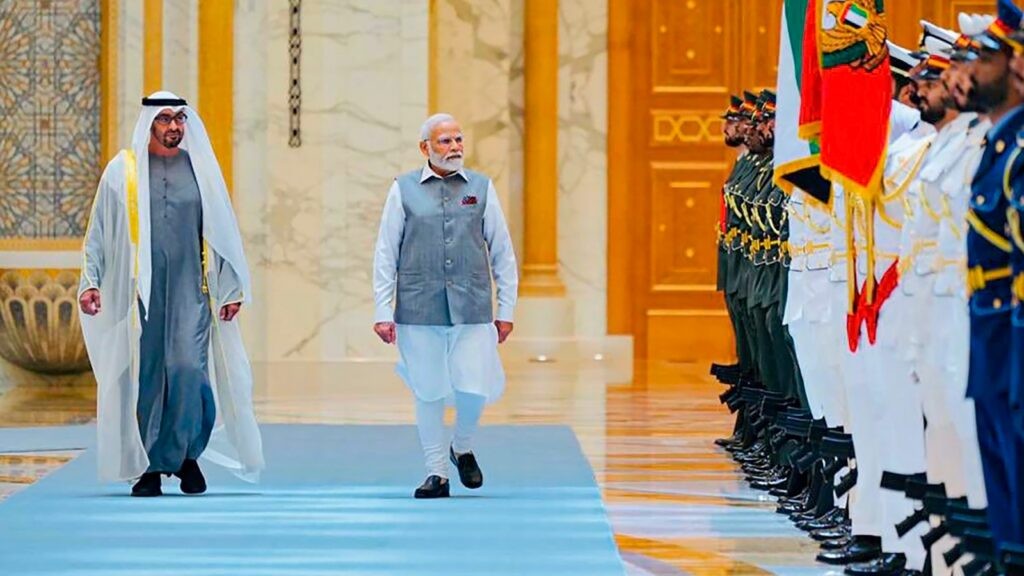The Local Currency Settlement System (LCSS) will be established as part of the MoU on adopting national currencies, with the goal of increasing the usage of the rupee and the dirham. All Capital and Current Account Transactions allowed under the Agreement are covered.
While in Abu Dhabi on Saturday, Indian Prime Minister Narendra Modi inked agreements with his UAE counterparts establishing real-time connectivity for cross-border transactions and facilitating the settlement of trade in national currencies.
During his visit with UAE President Sheikh Mohamed bin Zayed Al Nahyan, Modi, and Sheikh Mohamed signed an agreement to establish an IIT Delhi campus in Abu Dhabi.

UAE and India Relationship
India’s attempts in recent years to enhance its engagement with West Asian governments have focused particularly on the United Arab Emirates in areas that range from security to trade. About 30 per cent of the population of the Emirates consists of Indian expats. The Comprehensive Economic Partnership Agreement (CEPA) was signed in February of 2022, facilitating increased bilateral trade.
Upon his arrival in Abu Dhabi, Modi was greeted by Crown Prince Sheikh Khaled bin Mohamed bin Zayed Al Nahyan. After that, he went to the presidential palace of Qasr Al Watan to meet with UAE President Sheikh Mohamed bin Zayed Al Nahyan.
Two memorandums of understanding (MoUs) were signed by the Reserve Bank of India (RBI) and the Central Bank of the UAE to establish a framework for the use of national currencies for transactions across borders and partnerships in interlinking payment and messaging systems.
How Both Countries Benefit from the Agreement
Modi praised the agreements between the two central banks in a tweet, calling them a “very important aspect of UAE and India cooperation” that will allow for more economic cooperation and simplified international financial dealings.
The LCSS will facilitate the growth of an INR-AED foreign exchange market by allowing exporters and importers to use domestic currencies for payment.
The RBI believes this agreement will also increase cross-border investment and remittances. By transacting in their home currencies, Indian expats in the UAE can save money and time when sending money home.
India might use this system to pay the United Arab Emirates, its fourth-largest energy provider, for oil along with other products it imports from the UAE. At the moment, India sends the UAE cash in exchange for oil.
Sustainable Development
In 2022-23, $84.5 billion was exchanged between the UAE and India in bilateral trade. The United Arab Emirates, which must import nearly all the food it consumes, has promised $2 billion to establish a network of food parks in India. Non-petroleum trade between the two countries is set to climb to $100 billion by 2030 under the parties’ agreement.
The group CEO of the Abu Dhabi National Oil Company (ADNOC) and incoming president of COP28, Sultan Al Jaber, met with Modi to discuss climate change mitigation. “Our discussions focused on ways to further sustainable development.” Modi tweeted about India’s role in this area, highlighting the country’s focus on Mission LiFE.
Vinay Kwatra, the foreign minister, has remarked that the two countries’ trade and economic partnership has flourished since the signing of the CEPA in 2022. He said the two deals would allow for greater strategic economic integration between the two sides by facilitating the settlement of commerce in their own currencies and connecting payment networks.
“The visit opens up new pathways to structuring similar arrangements with other countries in the region and beyond,” he said.
Disclaimer : The above empty space does not represent the position of this platform. If the content of the article is not logical or has irregularities, please submit feedback and we will delete or correct it, thank you!